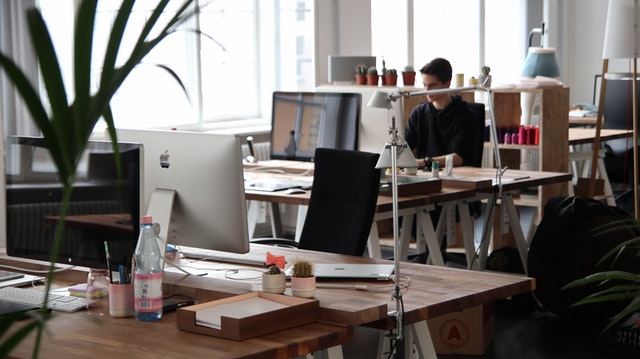Coronavirus has had a significant impact on every area of life over the last few months, principally the devastating effect of the disease on our health and wellbeing. Returning to work after lockdown will be hard, but we’re here to help.
As the curve is flattened and Covid-19 is brought under some semblance of control, we must start considering the steps we’ll need to take when lockdown is eased.
Governments around the world are looking at the safest way to transition back to normal life and restart their stalled economies, but what will individual businesses need to do to keep their employees and visitors safe and still run an effective, productive business?

Looking after the health and wellbeing of staff and visitors
One of the first decisions we face is how to safely bring staff back to work. We expect social distancing to be a part of life for the foreseeable future, so how can we incorporate that into our plans for repopulating the workplace?
The number of staff in the office at any point in the day will have to be carefully managed to allow them to keep a safe distance from other employees. This will involve looking at how desks are allocated, the use of common areas such as meeting rooms and lunchrooms as additional working areas and instigating a one-way system to allow staff to safely move around the office and maintain a safe distance from other people. Read more about coronavirus and your wellbeing here.
There are various ways to manage this.
- Where it is possible, some staff can continue to work from home
- Staggering start and finish times so fewer people are in the office at any time and this allows them to travel when public transport will be quieter.
- Operating a shift system to allow for the reduction in desk space
- Introduce a phased return to work beginning with essential staff who can’t work from home and gradually expanding this out to non-essential personnel.
If you opt for a hot-desking, staggered start or shift system approach, you must provide appropriate cleaning and sanitising wipes for staff to use prior to starting work at a desk so they can clean keyboards, telephones, mouse and desk surface and any other area of their workspace that has been used by another employee. This is in addition to a thorough cleaning each day by the cleaning/janitorial staff.
Common areas such as lunchrooms and canteens may need to be temporarily closed or limit the number of people able to use the facilities at any time.
To ensure staff are safe at work, it may be advisable to provide several hand sanitising stations throughout the offices to allow staff to sanitise their hands when they have to touch a hard surface such as a door handle that will have been used by other members of staff or, additional hand washing areas so that staff can comply with the government’s recommendation to regularly wash their hands for a minimum of 20 seconds.
Ensure buildings are safe and ready
We’ve addressed how to bring staff back to work safely, next we must consider the building that we’re bringing them into and how to ensure that it is a safe environment for all members of staff and visitors. Learn more about what we do here.
Prior to staff returning to work after lockdown, the office space will almost certainly need to undergo a deep clean to ensure it is free from any contamination. Additionally, a program of regular ongoing cleaning throughout the day in high-traffic areas – toilets, lobby areas and other communal areas may need to be implemented as well as the normal daily cleaning schedule that was in place prior to the pandemic.
If an employee shows Covid-19 symptoms while at work, a deep clean will be required to ensure that other staff members remain safe and infection free.
To mitigate the risk of Covid-19 being inadvertently brought into our offices by staff or visitors, mandatory screening could be implemented as people enter the building. This could be as simple as checking each person’s temperature with an infrared thermometer and if it is above a certain reading, they would need to be advised to return home and consult a doctor or self-isolate. Learn how Graduate Recruitment has evolved since Coronavirus.
Effective guidelines for managing your space for your return to work after lockdown
When it comes to returning to work after lockdown, One of our most important problems to address is maintaining social distancing throughout the workspace and communal areas.
By maintaining some staff working from home and either staggering start times or implementing a shift system, we reduce the number of people circulating in the office, but we must still ensure the remaining people will be able to maintain social distancing.
When staff enter and exit the offices, how are they going to get to their desk after they have been screened and cleared to enter?
If there are more than one set of stairs, then a one-way system can be adopted leaving the lift available for staff who have mobility issues or are wheelchair users.
In the office, desks must be two metres apart and not face-to-face. This will impact the maximum number of staff that can be in the office at any one time. Using the shift system or even a part office, part home-working approach will avoid overcrowding and allow for the reduction of usable desks.
Toilets and office kitchens can be a sticking point. If the kitchen remains available, remove shared coffee cups and crockery to avoid cross-contamination and ask staff to bring in personal mugs and plates for their sole use. Staggering lunchtimes will ease the problem of too many people in the kitchen and will also help avoid queuing for toilets.
Meetings, both internal and external should ideally be held using video conference software rather than in person. This eliminates the awkwardness of keeping to the social distancing requirements and avoids outside visitors inadvertently tracking Coronavirus into the office space.
Economically it is imperative that we can get back to work from both a personal and national perspective. However, it is equally important that all social distancing guidance are followed so we can avoid a second peak of Coronavirus and another enforced lockdown. By carefully analysing our staffing requirements and resources we’ll be able to take a ‘business as usual’ approach while keeping employees and visitors safe. Returning to work after lockdown will be hard for everyone but follow these steps to have the safest experience possible.



